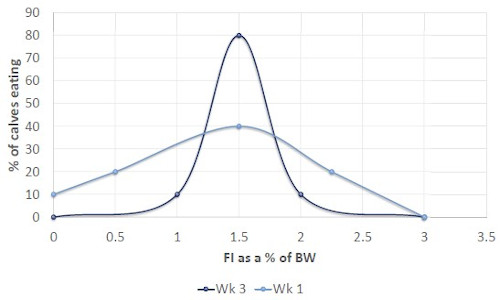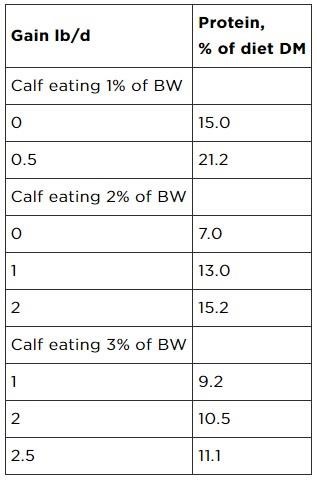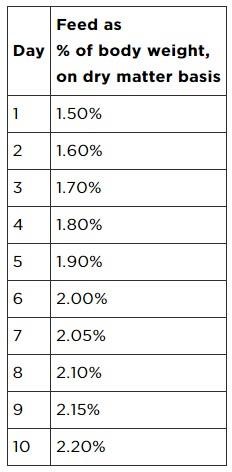Even though intake is critical to growth, cattle that are experiencing multiple stressors, like cattle transitioning to a feedlot, do not eat well. In fact, the intake pattern of cattle during the first week in the feedlot is usually erratic. Intake varies among cattle and throughout the first days, as shown in Figure 2. According to research, the “normal” feed intake for cattle will not resume until 21 days after feedlot entry. Thus, focusing on nutrition during these early days will play a very important role in the success of the feedlot. By the end of the 21 to 28-day transition period, feed intake should become more uniform and cattle will consume closer to the desired amount of feed.

Figure 2. Change in pattern of feed intake (FI as a % of body weight) by newly weaned calves transitioning to feedlot on weeks 1 and 3 after arrival. Figure courtesy of Dr. Tara Felix, Penn State Extension.
One of the challenges of erratic intake behavior is that it may lead to ruminal acidosis. Ruminal acidosis occurs when there is a more rapid production of acids in the rumen than the rumen wall, or epithelium, can absorb. The acid production drops ruminal pH and can cause ruminitis, or inflammation of the rumen epithelium. Ruminitis is thought to increase the passage of bacteria from the rumen into the bloodstream. Those bacteria can lodge in the liver and lungs, ultimately causing liver abscesses and pneumonia. Many times, feedlot operators do not realize acidosis has occurred; however, digestive disorders are the second most abundant cause of morbidity in confined cattle, behind only respiratory conditions. Any morbidity, or sickness, can reduce cattle growth throughout the entire feeding period. Thus, the goal during transition should always be to alleviate digestive upsets and to maintain digestive function.
One of the first nutritional challenges of the transition period is to adjust cattle, and the rumen, to a grain-based diet. Because it takes time for the rumen to adjust to dietary changes, it is necessary to adapt cattle to a high-grain diet by gradually increasing grain concentration in the diet and decreasing fiber content (Table 1). Many nutritionists recommend a 14 to 21-day transition to grain, depending on whether or not cattle have ever been fed grain. Weaned calves often come from pasture-based systems with little exposure to grain prior to feedlot entry, thus, a slow transition, similar to that in Table 1, over 21 days, is often recommended. Slower dietary transitions as cattle move from pasture to feedlots (grain diets) are crucial and can help reduce the number of digestive upsets encountered in the feedlot.
Table 1. Suggestion on how to slowly transition the diet from forage-based to grain-based.

Click here to view Table 1 from PSU
In addition to a slow transition to grain, controlling or managing intake, can help alleviate digestive upsets. Keep in mind that while animals are transitioning to grain, the energy density of the diet is increasing. Corn contains roughly twice as much energy as hay. Therefore, simply transitioning to grain is increasing the energy density of the diet and energy consumption of the animal. Cattle crave consistency. By limiting intake while grain is being introduced, the nutritional changes (intake and energy density) the calf is exposed to each day are limited.
While managing cattle intakes, it is important to remember that nutrition is more about consumption than concentration. While diets are often discussed on a percent crude protein (CP) basis, cattle require a certain amount – pounds or grams - of protein every day. Thus, when intakes are restricted, a greater protein concentration must be fed in the diet in order to meet the pounds per day requirements of the growing cattle (Table 2).
Table 2. Dietary protein needs of a 400-lb calf at different rates of body weight (BW) gain.1

Click here to view Table 2 from PSU
Once cattle are consuming the final diet, feed offered can be gradually increased (as in Table 3). After adaptation to grain, begin increasing feed delivery slowly by 5% after 3 days of consistent intake and clean bunks. Monitor cattle intakes daily to ensure that cattle are cleaning up feed offered, but not running out of feed. Poor feed bunk management can result in erratic intake patterns and lead to acidosis and lost revenue to the producer because of feed loss or hungry cattle. When this occurs, feed conversion is not maximized. Respect a minimum period of adaptation to the diet (21 days). By limiting intake initially and then gradually increasing the amount of feed offered, after cattle are fully transitioned to grain, cattle feeders can improve the success of the transition.
Table 3. One example of how to slowly increase feed offered to weaned calves during transition to feedlot

Click here to view Table 3 from PSU
Adapted from: Dr. Francis Fluharty, 2017. How to transition calves to grain-based diets.
Cattle feeders are constantly challenged when transitioning calves to the feedlot. While these tips can help, working closely with a nutritionist, to formulate receiving diets and nutritional management meet the requirements of newly weaned calves, and a veterinarian, to establish protocols to protect the health of the herd, is encouraged to ensure a successful transition to the feedlot.
Source : psu.edu